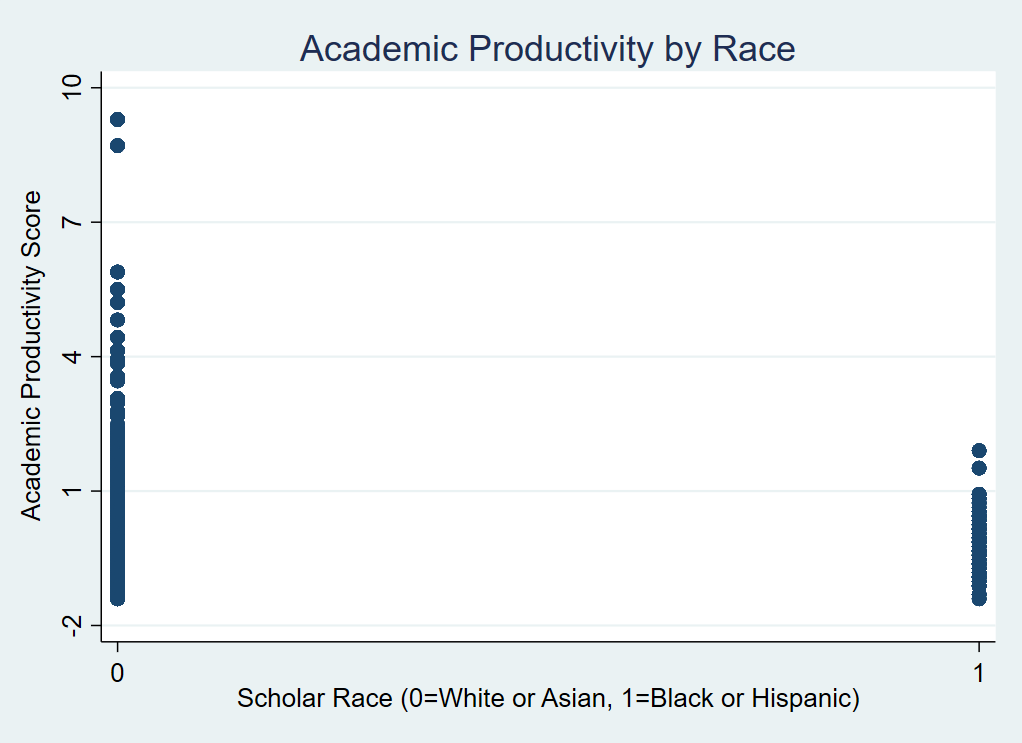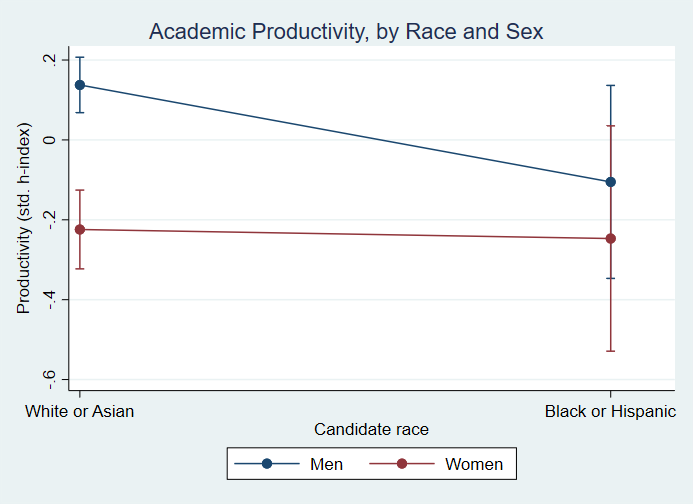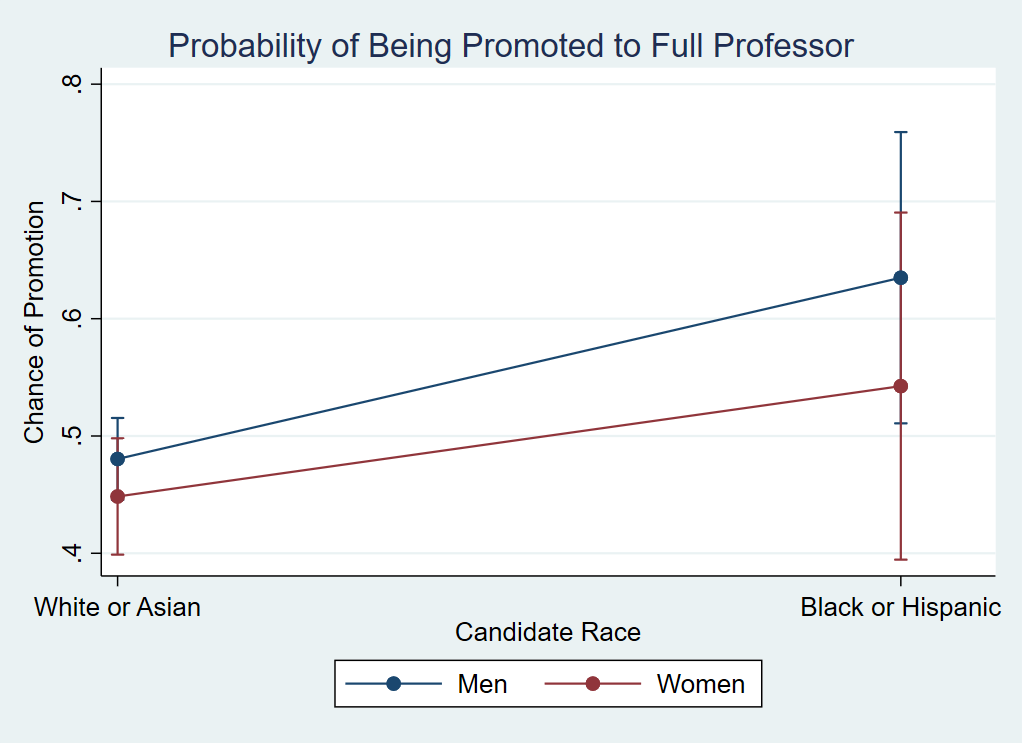Junk Science is being used to Prop up DEI
It's even worse than I thought
What follows is an updated and expanded version of the short piece I published at Unherd four days ago. Whereas I had thought the authors of a paper claiming discrimination against minority scholars in academia were only guilty of burying their key findings while touting weak results, it now looks like their results are garbage: a result of sloppiness, mendacity, or both. This tells us a great deal about the knowledge production system in the social sciences, and how it systematically skews what experts consider to be the ‘truth’ and ‘settled science’.
Diversity, Equity and Inclusion (DEI) is on the ropes these days. This is a big problem for institutions, such as most elite universities or Science magazine, that have invested deeply in this belief system. One way to rescue the enterprise is to tout new scientific results that buttress the claim that minorities and women are discriminated against in academia. Ergo the need for affirmative action.
Now the woke popular science magazine Science is trumpeting a new academic paper in the equally woke Nature Human Behaviour as a riposte to the naysayers. ‘Racial bias can taint the academic tenure process,’ screams the headline.
The paper’s authors claim Black and Hispanic academics with the same track record are discriminated against when they come up for tenure and promotion. But their data, if anything, points to anti-White/Asian bias, propping up weak results while covering up inconvenient but powerful findings.
The authors briefly admit that disadvantaged minorities are advantaged over Whites and Asians when it comes to being promoted to full professor. But, at an earlier career stage, when moving from a relatively insecure non-tenured professorship to a secure tenured professorship, they are discriminated against. This helps explain minority underrepresentation in academia.
I was curious so I downloaded and crunched their data. Looking under the hood, I find the paper to be junk science. The term ‘p-hacking’ is used to describe quantitative analysis that tortures the data to find a significant finding that can be spun to support one’s priors. Consider what the authors did:
First, they did not pre-register the hypothesis they were going to test, allowing them to flex their hypothesis to match what they could mine from the data using a trial-and-error approach.
Second, they downplayed their strongest findings because these did not fit the narrative.
What did they find?
First and foremost, that Black and Hispanic scholars are much less productive than White and Asian scholars, controlling for scholarly discipline and years as an academic. The scatterplot below shows the spread of academic output scores for the 8,157 Whites/Asians and 776 Blacks/Hispanic points in the data. This is based on standardizing the h-index, a measure of how many times a scholar’s number of publications has been cited. The difference is significant at the powerful .1 percent (p<.001) level, but this goes unreported in the paper. The same pattern shows up in the sciences as it does in the social sciences and humanities.
The mean score for minorities is -.26 compared to .03 for Whites/Asians, a massive 29-point gap.
Women underperform men by an even larger amount: among men it’s .12 and women -.23, a 35-point gap.
I next ran this as a statistical model to see how race and gender interact to influence productivity. I controlled for years in present rank and discipline of study, but removing these controls does not alter the general findings. The results, in Figure 2, show that Whites and Asians (left points on chart) are more productive than Blacks/Hispanics (right points), but that this difference is only there among men (blue line), with no racial difference among women (red line). Women are less productive than men, but the gender gap among Black and Hispanic scholars is not statistically significant.
Their second knockout finding is that Black and Hispanic candidates for full professor are significantly more likely to get promoted for their level of publications and grants than White or Asian candidates. Figure 3 shows a 10-20 point advantage for minority candidates over Whites/Asians. This result is again significant at the powerful .1 percent level. While this finding is briefly reported in the body of the paper, it is downplayed in the abstract, conclusion and marketing.
Women are not advantaged over men (there is no significant gap between the lines taking into account error bars) when it comes to promotion to professor the way that minorities are over Whites and Asians. In short, academia discriminates against White and Asians when it comes to promoting people to professor.
Only after stating these major effects would I start torquing the data with interaction effects the way the authors did to get at minor results, but they needed to tell a story that meshes with the hegemonic systemic discrimination narrative.
To do this, the authors created a measure that compares Blacks/Hispanics with weak publication records with Whites/Asians with strong publication records. They find that minorities with weak publications are treated more harshly in promotion to the associate professor-with-tenure level than similarly qualified Whites/Asians.
Their result for associate professor-with-tenure is significant, but more weakly, at the 5 percent level on one measure and 1 percent level on another.
This seems like a weak, oblique finding. But then someone online pointed out that they had inflated their number of data points dramatically. The data actually contained only 1571 tenure cases but 9032 data points. Most of these are duplicates, with each person multiplied out by the number of academics that wrote letters to support their tenure case.
It turns out that even their headline findings about discrimination within lower-productivity academia falls away when you deflate their data!
As my correspondent wrote, ‘When you remove the duplicates and filter to those who have H-index values and votes from the college, the total sample is n = 1060. The total Black and Hispanic sample is n = 93.’ So they are basing their claims on 93 Black and Hispanic academics. In fact they are comparing just 58 low productivity Black and Hispanic academics with 502 low productivity White/Asians.
Worse, if we look at very low productivity (h below -1) minority women who got voted down by their committee, there are only 2 individuals, and there is only 1 minority male academic to compare to. Even with a broader definition of low h-index scores (below 0) we get just 8 minority women. Any mismeasurement, randomness or omitted characteristic about these handful of individuals would alter the results dramatically.
[**Slight correction: it turns out they did use the 1571 for analysis, and I have managed to reproduce their analysis and get a significant interaction for minority women. But at low h-index scores we have little to no observations for minority women. There are just 8 minority women with nonzero scores in the low h-index zone. Few of the mean comparisons are significant and some of those go away if you use a nonparametric test, given that they're not normal distributions with most values at 0 negative votes. Bottom line remains: this is not a robust study with findings likely to replicate.]
They jumped at the results they wanted and got careless. Reviewers eagerly lapped it up. Science magazine ran with it. Inconvenient findings got buried. This is how science works when it gets near anything related to the holy DEI trinity of race, gender and sexuality.
Add one more paper to the mountain of junk that makes up the replication crisis in the social sciences.
Most academic proponents of DEI, or Social Justice, rely on pseudo-conspiratorial meta-theories like critical race theory or flabby qualitative methods like ‘auto-ethnography’ (a.k.a. contemplating one’s navel) to buttress their knowledge claims. No wonder James Lindsay, Helen Pluckrose and Peter Boghossian were able to publish so many hoax papers in grievance studies journals merely by parroting feminist and critical race theory buzzords.
However, laundering woke ideas enough to sell them to organizations requires at least some scientific patina. Even a thin quantitative foundation can be enough to backstop what Doug Stokes terms the grievance-industrial complex, with its well-remunerated institutional programme of radical indoctrination and race or sex discrimination. We’ve seen this with claims of sex discrimination in academia, which have failed to replicate, and with shoddy arguments that diversity improves corporate performance. Rigorous and high-powered studies which come to the wrong conclusions go uncited while junk papers like this one grab the limelight and make into diversity training workshops.
This is a perfect illustration of why we need new initiatives such as my Centre for Heterodox Social Science at the University of Buckingham, Britain’s only free speech university. There will be new major announcements from the Centre, so stay tuned.
Don’t get fooled again by experts claiming that DEI rests on scientific evidence.





All this arrant DEI nonsense puts me in mind of a Saul Bellow quote: "A great deal of intelligence can be invested in ignorance when the need for illusion is deep" In these few words he hit the nail on the head about the nature of our wokeified academia in the Western world. Anyone who has read Heather Mac Donald's comprehensive study of campus DEI The Diversity Delusion could be left in no doubt about who is really discriminated against in universities. But of course the kind of people who need to be put straight on all this, won't ever read anything that doesn't indulge their infantile virtue-signalling prejudices. https://grahamcunningham.substack.com/p/how-diversity-narrows-the-mind
I really like that you are taking the time to really analyze the findings of this article. As a former professor, I know how often subpar articles get published if they enhance the ideological agenda of the academic Left. This, unfortunately, gives the professor who published the article enhanced status and encourages other professors to do the same. Worse, it then gets amplified by the mainstream media.
We need to fight this process by showing how fraudulent these studies are. Hopefully, if professors learn that the more Woke their conclusions, the more likely it is to get torn apart in public, then this creates somewhat of a counter-balance in incentives. This will not stop the process, but it might reduce the negative impact on the rest of society.
Keep doing this!